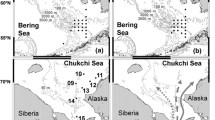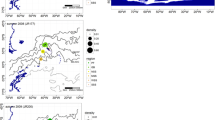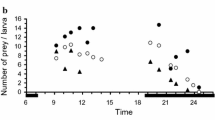Abstract
The vertical distribution of jack mackerel Trachurus japonicus larvae was described based on discrete depth sampling using a MTD net system from the surface down to 100 m depth at 13 stations in the southern East China Sea between 27 February and 10 March 2002. Of the 20 782 fish larvae collected, T. japonicus larvae were most abundant, accounting for 37.0% of the total catch. The average abundance of the larvae was 419.0 individuals/10 m2, with the average (±standard deviation [SD]) body length of 2.6±0.3 mm (range 1.8–7.5 mm). The larvae were concentrated in the mixed layer, with peak densities in the 10–30 m layer. The average (±SD) weighted mean depth was 21.5±7.8 m. There was no evidence of either diel or ontogenetic vertical migration for the early larvae of <5 mm. More than 90% of the T. japonicus larvae were collected in the water temperature ranging from 21 to 23°C. Vertical profiles of the larval densities and chlorophyll a coincided with each other, which might reflect the abundance of their main prey organisms, copepod nauplii and copepodites, since copepod production is known to be closely related with the chlorophyll a concentration.
Similar content being viewed by others
References
Tsujita T, Kondo M. Some contributions to the ecology of the mackerel and the oceanography of the fishing grounds in the East China Sea (1). Bull. Seikai Reg. Fish. Res. Lab. 1957; 14: 7–47.
Enami T. Maturity and spawning habits of mackerels. Rep. Tsushima Warm Current Exploitation Utilization Res. 1958; 4: 39–50 (in Japanese).
Asami T. Distribution of fish eggs and larvae in the southern Japan and its significance of source of the supply of fish stocks. Bull. Jpn. Soc. Fish. Oceanogr. 1974; 25: 176–193.
Ouchi A, Hamasaki S. Population analysis of the common mackerel, Scomber japonicus, based on the catch statistics and biological informations in the western Japan Sea and the East China Sea. Bull. Seikai Reg. Fish. Res. Lab. 1979; 53: 125–152.
Ochiai A, Tanaka M. Ichthyology. Koseisha-Koseikaky, Tokyo, 1986 (in Japanese).
Yoda M, Sassa C. Spawning grounds of jack mackerel. In: Hara I, Tokai T (eds). Spawning Ground and Recruitment Process of Jack Mackerel—from the East China Sea to the Coastal Waters of Japan. Koseisha-Koseikaku, Tokyo, 2004; 139: 19–30.
Sassa C, Konishi Y, Mori K. Distribution of jack mackerel (Trachurus japonicus) larvae and juveniles in the East China Sea, with special reference to the larval transport by the Kuroshio Current. Fish. Oceanogr. 2006; 15 (in press).
Komatsu K. Monitoring system of transport of eggs and larvae based on a numerical model. In: Hara I, Tokai T (eds). Spawning Ground and Recruitment Process of Jack Mackerel-from the East China Sea to the Coastal Waters of Japan. Koseisha-Koseikaku. Tokyo, 2004; 139: 92–103.
Fukataki H. Consideration on the recruiting process of the jack mackerel population in the Tsushima Current region. I. Consideration from occurrence and distribution of larvae. Ann. Rep. Jpn. Sea Reg. Fish. Res. Lab. 1960; 6: 69–85.
Kozasa E. An observation on the drift of larvae of jack mackerel in the East China Sea. Bull. Seikai Reg. Fish. Res. Lab. 1971; 39: 1–14.
Kidokoro H. Recruitment process in the Japan Sea. In: Hara I, Tokai T (eds). Spawning Ground and Recruitment Process of Jack Mackerel—from the East China Sea to the Coastal Waters of Japan. Koseisha-Koseikaku. Tokyo, 2004; 139: 83–91.
Uehara S, Mitani T. Recruitment process along the Pacific coast of Japan. In: Hara I, Tokai T (eds). Spawning Ground and Recruitment Process of Jack Mackerel—from the East China Sea to the Coastal Waters of Japan. Koseisha-Koseikaku, Tokyo. 2004; 139: 69–82.
Tanaka Y. Change of specific gravity of fish eggs and larvae and their distribution and movement in relation to current structure. In: Kawai E (ed). Current and Life—Lecture of Fisheries Oceanography. Kyoto University Press. Kyoto, 1991; 60–78 (in Japanese).
Kim HY, Sugimoto T. Transport of larval jack mackerel (Trachurus japonicus) estimated from trajectories of satellitetracked drifters and advective velocity fields obtained from sequential satellite thermal images in the eastern East China Sea. Fish. Oceanogr. 2002; 11: 329–336.
Komatsu K, Kawasaki K. Temporal variation of surface wind-drifted current observed by drifting buoys in the East China Sea. Bull. Fish. Res. Agen 2003; 7: 14–23.
Ahlstrom EH. Vertical distribution of pelagic fish eggs and larvae off California and Baja California. Fish. Bull. U.S. 1959; 60: 107–146.
Moser HG, Smith PE. Larval fish assemblages of the California Current region and their horizontal and vertical distributions across a front. Bull. Mar. Sci. 1993; 53: 645–691.
Motoda S. Devices of simple plankton apparatus V. Bull. Fac. Fish. Hokkaido Univ. 1971; 22: 101–106.
Fei Z, Li B, Kuroda K. Primary productivity in the northern East China Sea. Proceedings of China-Japan Joint Symposium of the Cooperative Research on the Kuroshio. China Ocean Press, Beijin, 1994; 453–469.
Yentsch CS, Mentzel DW. A method for the determination of phytoplankton chlorophyll and phaeophytin by fluorescence. Deep-Sea Res. 1963; 10: 221–231.
Kondo M. Oceanographic investigations of fishing grounds in the East China Sea and the Yellow Sea. I. Characteristics of the mean temperature and salinity distributions measured at 50 m and near the bottom. Bull. Seikai Reg. Fish. Res. Lab. 1985; 62: 19–66.
Ichikawa H, Beardsley RC. Review. The current system in the Yellow and East China Seas. J. Oceanogr. 2002; 58: 77–92.
Lie H-J, Cho C-H. Recent advances in understanding the circulation and hydrography of the East China Sea. Fish. Oceanogr. 2002; 11: 318–328.
Manda A, Isobe A, Matsuno T, Yanagi T, Han I-S, Kamio K. Temporal and spatial variations of the water mass distribution and current structure around the Kuroshio front in the East China Sea. Bull. Coastal Oceanogr. 2001; 39: 57–67.
Uchida K, Imai I, Mito S, Fujita S, Ueno M, Shojima Y, Senta T, Tahuku M, Dotsu Y, Studies on the Eggs, Larvae, and Juveniles of Japanese Fishes. Series. I. Second Laboratory of Fisheries Biology, Fisheries Department Faculty of Agriculture, Kyushu University. Fukuoka, 1958 (in Japanese).
Ochiai A, Mutsutani K, Umeda S. Development of eggs, larvae and juveniles of jack mackerel, Trachurus japonicus. Jpn. J. Ichthyol 1982; 29: 86–92.
Xie S, Watanabe Y, Saruwatari T, Masuda R, Yamashita Y, Sassa C, Konishi Y. Growth and morphological development of sagittal otolith of jack mackerel Trachurus japonicus in larval and early juvenile stages. J. Fish Biol. 2005; 66: 1704–1719.
Ida H. Some ecological aspects of larval fishes in waters off Central Japn. Nippon Suisan Gakkaishi 1972; 38: 981–994.
Nakata N, Imai C. Vertical distribution of eggs and larvae, in the coastal sea region, off Jogashima, Pref. Kanagawa. Bull. Kanagawa Pref. Fish. Stn. 1981; 3: 19–27 (in Japanese).
Sakamoto T, Takeuchi J, Yoshimura K, Ogawa M. Distribution of jack mackerel larvae and juveniles in the coastal area off southern Kii-peninsula. MRP Prog. Rep. 1984; 2: 59–81 (in Japanese).
Suzuki T, Konishi Y. Distribution of larval fish and copepod nauplius in Tosa-Bay in 14–15 April 1981. Fish. Biol. Oceanogr. South-Western Waters Jpn. 1986; 2: 15–25 (in Japanese).
Olivar MP. Spatial patterns of ichthyoplankton distribution in relation to hydrographic features in the Northern Benguela region. Mar. Biol. 1990; 106: 39–48.
Coombs SH, Morgans D, Halliday NC. Seasonal and ontogenetic changes in the vertical distribution of eggs and larvae of mackerel (Scomber scombrus L.) and horse mackerel (Trachurus trachurus L.). Fish. Res. 2001; 50: 27–40.
Japan Meteorological Agency. Geophys. Rev. 2002; 1230: 1–70.
Tanaka M. Feeding and survival in marine fish larvae-V. Vertical distribution and migration of eggs and larvae. Aquabiology 1981; 16: 379–386.
Blaxter JHS, Hunter JR. The biology of the clupeoid fishes. Adv. Mar. Biol. 1982; 20: 3–194.
Ware DM, Lambert TC. Early life history of Atlantic mackerel (Scomber scombrus) in the southern Gulf of St. Lawrence. Can. J. Fish. Aquat. Sci. 1985; 42: 577–592.
Neilson JD, Perry RI. Diel vertical migrations of marine fishes: an obligate or facultative process? Adv. Mar. Biol. 1990; 26: 115–168.
Shojima Y. On the postlarvae and juveniles of carangid fishes collected together with jelly-fishes. Bull. Seikai Reg. Fish. Res. Lab. 1962; 27: 47–58+1 plate.
Ochiai A, Umeda S, Taniguchi N. Mortality of reared jack mackerel at early developmental stages. MRP Prog. Rep. 1983; 1: 17–25 (in Japanese).
Ochiai A, Umeda S, Taniguchi N. Mortality of reared jack mackerel larvae and juveniles in relation to feeding density. MRP Prog. Rep. 1984; 2: 31–37 (in Japanese).
Nakata K, Nakano H, Kikuchi H. Relationship between egg productivity and RNA/DNA ratio in Paracalanus sp. in the frontal waters of the Kuroshio. Mar. Biol. 1994; 119: 591–596.
Noguchi T. Study of water mass and prey condition of fish larvae in the shelf-break region of the East China Sea. Master Thesis, University of Nagasaki, Nagasaki. 2004 (in Japanese).
Author information
Authors and Affiliations
Corresponding author
Rights and permissions
About this article
Cite this article
Sassa, C., Konishi, Y. Vertical distribution of jack mackerel Trachurus japonicus larvae in the southern part of the East China Sea. Fish Sci 72, 612–619 (2006). https://doi.org/10.1111/j.1444-2906.2006.01191.x
Received:
Accepted:
Issue Date:
DOI: https://doi.org/10.1111/j.1444-2906.2006.01191.x




